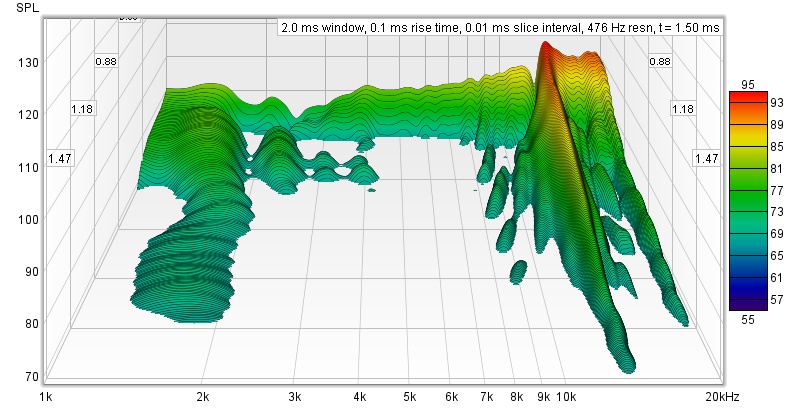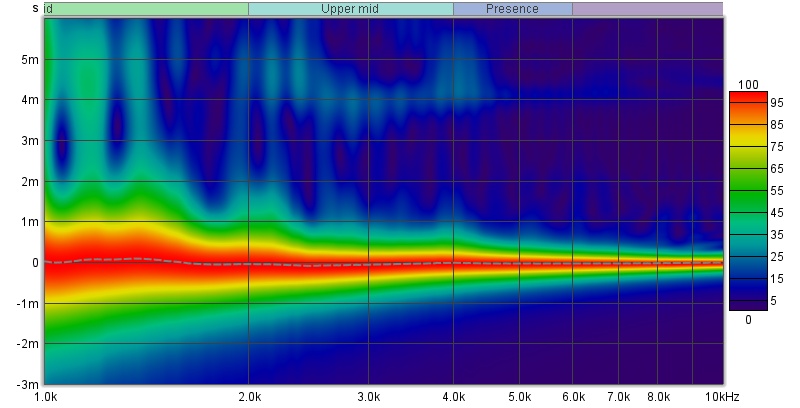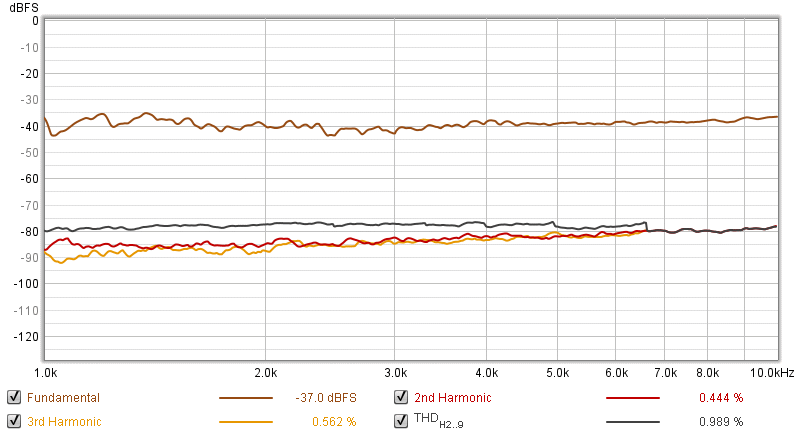|
Dayton PC83-8 Frequency Response (manufacturer) The plot above is from Dayton. It shows a flat response from 1kHz~10kHz. After that, the cone breakup extends the super highs to 20kHz.
Fig 1 is my measurement of the PC83-8 with her loaded onto a 7 liters sealed box that I used in the Chickadee. It resembles the response from the manufacturer except for the slight baffle step of about -3dB. That’s due to a baffle width of 8″ whereas Dayton’s PC83-8 was mounted onto an IEC panel. What distinguishes this PC83-8 from the HiVi C3N-III is the flatness from 2kHz~10kHz. That indicates the treble will be smooth. At 15kHz is the cone breakup.
The Waterfall plot (Fig 2) recorded decays at 1.5kHz and 15kHz. The former is the peak seen in Fig 1. The artifacts caused by the cone breakup at 15kHz is clearly visible.
The Toneburst plot in Fig 3 presents a clearer picture of what is happening in the frequency response (Fig 1). The artifacts at 1.5kHz seen in the Waterfall plot (Fig 2) are the light blue slices of unwanted energy. They last for four cycles. Farther up, there are a bunch from 15kHz~20kHz which are from the cone breakup. What is remarkable is there are no unwanted energy from 2.5kHz~10kHz. This confirms what is recorded in the Waterfall plot.
The Spectrogram in Fig 4 is a 2D view of the Toneburst and Waterfall plots. Now that time is on the Y-axis, it’s easier to see how long the artifacts last. From 2.5kHz~10kHz, there are virtually no artifacts. This will translate to a pristine upper midrange all the way to the higher end of the treble. More than that, the response is flat, contributing to the driver’s accuracy in reproduction. Below 2kHz, there are some “bleed” from 1kHz~1.5kHz but they will not smear the midrange as they dissipate by 6 msec.
The Step response (Fig 5) shows “ringing” after the first peak. My guess is these are from the cone breakup at 15kHz.
The Harmonic Distortion in Fig 6 doesn’t show any anomalies. THD from H2~H9 is slightly higher than the HiVi C3N-III but I wouldn’t read too much into this because it could be due to some leakages in the woofer mounting. I will run more tests later but even with these figures, I couldn’t pick out anything amiss during auditioning. Summary I have been listening to this Dayton PC83-8 for a few days and I couldn’t find any faults. Her tonal balance is better than the HiVi C3N-III in that there’s more bass. Furthermore, the flatness from 2.5kHz~10kHz ensures there’s no excessive sibilance. Treble is smooth, no harshness whatsoever. This is extraordinary for a budget driver. It looks like I will use the PC83-8 for the column in my Evolve clone. It does cost more ($93.44) but it’s only about $20 extra compared to the HiVi C3N-III ($72.16). Apart from the column, the PC83-8 is a good choice for a Sound Bar, an MTM or even a stand alone full range bass reflex. I was pleasantly surprised by the bass coming out of this 3″ driver. Though it’s not very loud and doesn’t go very low, it is audible, particularly the upper bass. Unless otherwise stated, all measurements were made in Full Space (4 pi) with the mic at 36 ins, tweeter axis. Impulse Window=5ms. No smoothing applied. |

August 31, 2023HIFI DRIVERS

 Fig 1 – PC83-8 Frq Response • Baffle Width = 8″
Fig 1 – PC83-8 Frq Response • Baffle Width = 8″ Fig 2 – PC83-8 Waterfall
Fig 2 – PC83-8 Waterfall Fig 3 – PC83-8 Toneburst Energy Storage
Fig 3 – PC83-8 Toneburst Energy Storage

